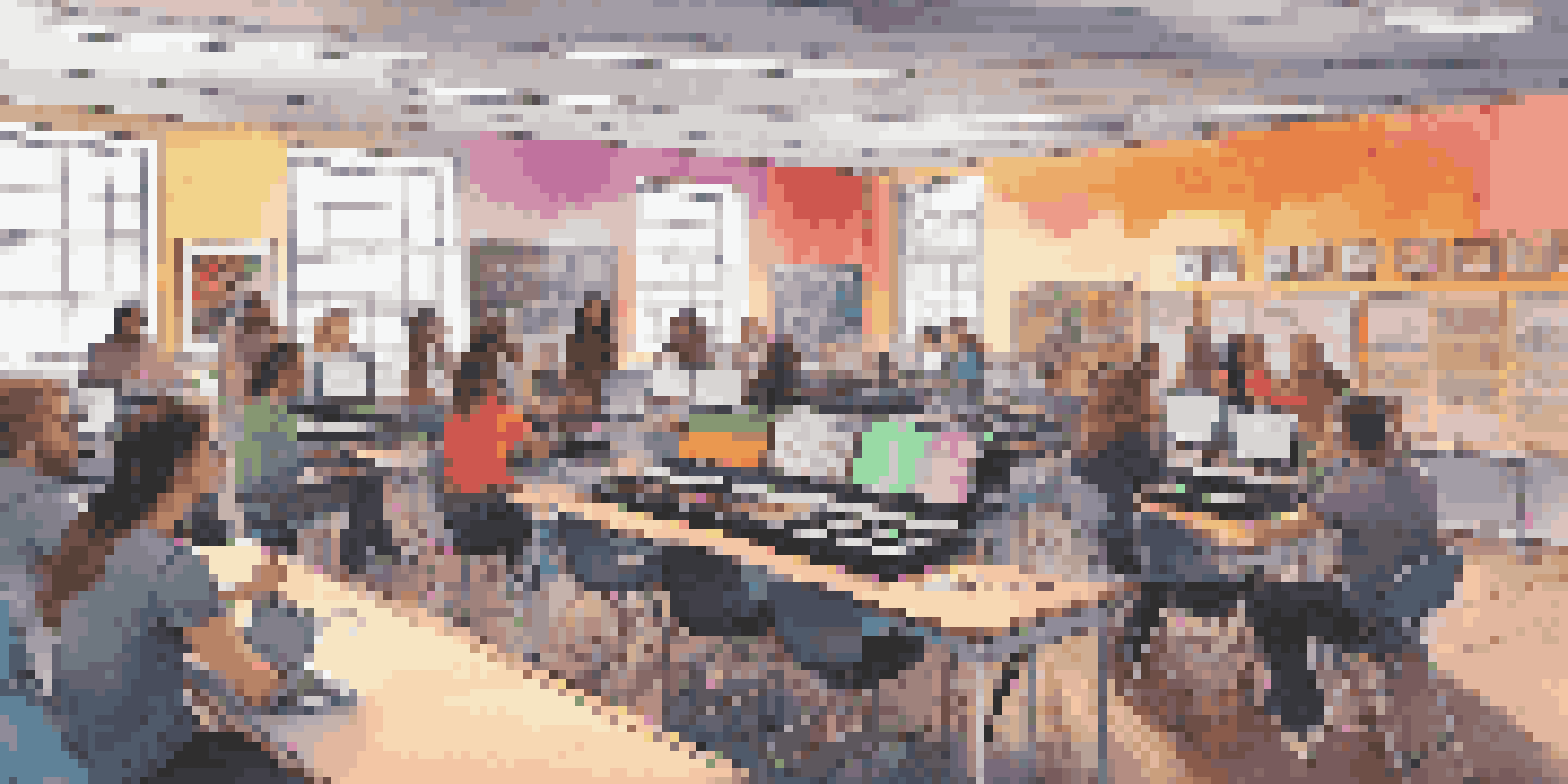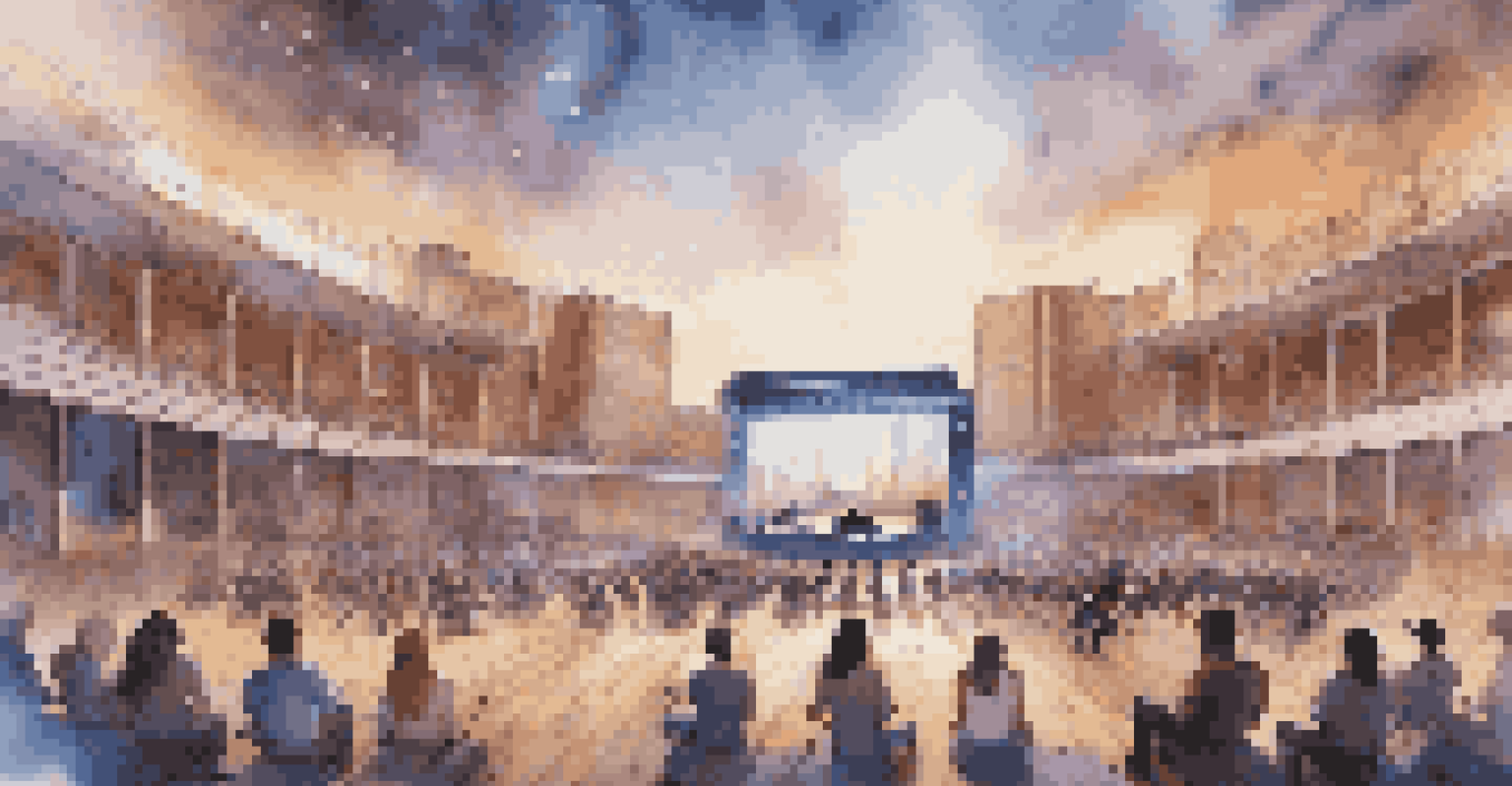Exploring Music Technology Trends in Today's Classrooms

The Rise of Music Production Software in Education
In recent years, music production software has become a staple in classrooms. Tools like GarageBand and Ableton Live provide students with hands-on experience in music creation. These platforms allow learners to explore their creativity without needing a traditional music background. By integrating these tools into the curriculum, educators can foster a deeper understanding of music theory and composition.
Music can change the world because it can change people.
Imagine a classroom where students can compose their own tracks using just a laptop. This shift not only engages students but also prepares them for careers in the music industry. Plus, the accessibility of these programs means that all students, regardless of skill level, can participate. This democratization of music creation is a game-changer for educational settings.
Moreover, using production software promotes collaboration among students. They can work together on projects, sharing ideas and techniques, which enhances their social skills and teamwork. The result is a vibrant classroom environment that embraces innovation and creativity.
The Role of Online Music Learning Platforms
Online music learning platforms are redefining how students access music education. Websites and apps like Yousician and SmartMusic offer interactive lessons that cater to various skill levels. This flexibility allows students to learn at their own pace, making music education more personalized and effective. Additionally, they can practice at home, reinforcing what they’ve learned in class.

These platforms often feature gamification elements, turning practice into a fun and engaging experience. Students can earn points and badges, which motivates them to continue improving. This approach creates a sense of achievement and encourages a lifelong love for music. As a result, students are not just learning an instrument; they’re developing a passion for music.
Tech Enhances Music Education
The integration of music production software and mobile apps allows students to engage with music creatively and collaboratively, regardless of their skill level.
Furthermore, online platforms can connect students with professional musicians and educators globally. This exposure broadens their musical horizons and introduces them to diverse styles and techniques. It’s an enriching experience that traditional classroom settings might not provide.
Integrating Mobile Apps for Music Learning
Mobile apps are transforming music education by putting learning tools right in students' pockets. Apps like GarageBand and Noteflight allow students to compose, notate, and share music anytime, anywhere. This convenience enhances learning opportunities beyond the classroom, encouraging students to engage with music regularly. It also allows for immediate feedback, which is crucial for skill development.
Technology is best when it brings people together.
Think about a student who can practice their instrument while waiting for a bus. With the right app, they can use that time to refine their skills or explore new musical ideas. This integration of technology supports a more fluid learning experience, where students can learn in real-time and apply their knowledge practically.
Moreover, these apps often include community features where students can share their work and receive feedback from peers. This fosters a sense of belonging and encourages collaboration, further enriching the educational experience. By utilizing mobile technology, educators can create a more dynamic and engaging learning environment.
The Impact of Virtual Reality in Music Education
Virtual reality (VR) is making waves in music education, offering immersive experiences that were once unimaginable. With VR, students can step into a virtual concert hall or even jam with their favorite artists in a simulated environment. This technology not only captivates students' attention but also enhances their understanding of music concepts through experiential learning.
Imagine a student practicing their instrument in a VR setting where they can receive real-time feedback on their technique. This kind of immersive learning can accelerate their progress and build confidence. Additionally, VR can introduce students to various music cultures and styles, promoting diversity in their musical education.
AI Personalizes Learning Experience
Artificial intelligence provides tailored feedback and personalized exercises, significantly improving students' learning outcomes in music education.
As VR technology becomes more accessible, its applications in education will likely expand. This innovation could lead to more engaging and interactive lessons, making music education both fun and effective. The potential for creativity and exploration is endless, paving the way for the future of music learning.
Harnessing Artificial Intelligence in Music Education
Artificial intelligence (AI) is revolutionizing music education by providing personalized learning experiences. AI-driven platforms can analyze a student's playing style and offer tailored feedback, helping them improve at their own pace. This targeted approach can significantly enhance learning outcomes, catering to each student's unique needs and abilities.
For example, an AI program might suggest specific exercises based on a student's weaknesses, making practice sessions more effective. This level of customization can lead to faster progress and increased motivation. By integrating AI into music education, teachers can better support their students' development and foster a love for music.
Moreover, AI can assist in composition by generating music ideas or suggesting chord progressions. This allows students to explore their creativity without the fear of getting stuck. The fusion of AI and music education opens up new possibilities for creativity and innovation, making learning more exciting.
Collaborative Music Creation with Technology
Technology has made collaborative music creation more accessible than ever. Platforms like Soundtrap allow students to work together on projects in real-time, regardless of their physical location. This collaboration fosters teamwork and communication skills, essential traits in today's interconnected world. Plus, it mirrors the collaborative nature of the music industry, preparing students for future careers.
Consider a group of students from different schools coming together to create a song. They can share ideas, edit tracks, and provide feedback, all while learning from each other’s strengths. This not only enhances their technical skills but also promotes a sense of community and shared purpose.
VR Offers Immersive Learning
Virtual reality technology creates immersive experiences that enhance understanding and engagement in music education, introducing students to diverse musical cultures.
Additionally, collaborative projects can lead to more diverse musical expressions. Students can blend different genres and styles, resulting in unique pieces of music. This diversity enriches their learning experience and encourages them to think outside the box.
The Future of Music Technology in Classrooms
As technology continues to evolve, its role in music education will only expand. Educators are increasingly recognizing the importance of integrating these tools into their teaching methods. This shift not only enhances learning outcomes but also prepares students for a rapidly changing world where technology and music intersect.
Imagine classrooms equipped with the latest technology, where students can explore music in ways we never thought possible. From AI to VR, the possibilities are endless. As these tools become mainstream, they will revolutionize how music is taught and experienced.

Ultimately, the future of music technology in education is bright. By embracing these innovations, educators can create engaging and effective learning environments that inspire students to pursue their musical passions. The integration of technology in music education is not just a trend; it's a fundamental shift that will shape the future of learning.